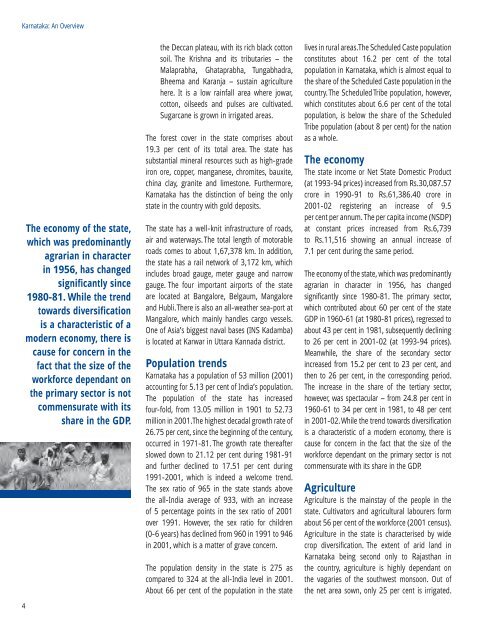Human Development Report 2005 : Karnataka - United Nations ...
Human Development Report 2005 : Karnataka - United Nations ...
Human Development Report 2005 : Karnataka - United Nations ...
You also want an ePaper? Increase the reach of your titles
YUMPU automatically turns print PDFs into web optimized ePapers that Google loves.
<strong>Karnataka</strong>: An Overview<br />
4<br />
The economy of the state,<br />
which was predominantly<br />
agrarian in character<br />
in 1956, has changed<br />
significantly since<br />
1980-81. While the trend<br />
towards diversification<br />
is a characteristic of a<br />
modern economy, there is<br />
cause for concern in the<br />
fact that the size of the<br />
workforce dependant on<br />
the primary sector is not<br />
commensurate with its<br />
share in the GDP.<br />
the Deccan plateau, with its rich black cotton<br />
soil. The Krishna and its tributaries – the<br />
Malaprabha, Ghataprabha, Tungabhadra,<br />
Bheema and Karanja – sustain agriculture<br />
here. It is a low rainfall area where jowar,<br />
cotton, oilseeds and pulses are cultivated.<br />
Sugarcane is grown in irrigated areas.<br />
The forest cover in the state comprises about<br />
19.3 per cent of its total area. The state has<br />
substantial mineral resources such as high-grade<br />
iron ore, copper, manganese, chromites, bauxite,<br />
china clay, granite and limestone. Furthermore,<br />
<strong>Karnataka</strong> has the distinction of being the only<br />
state in the country with gold deposits.<br />
The state has a well-knit infrastructure of roads,<br />
air and waterways. The total length of motorable<br />
roads comes to about 1,67,378 km. In addition,<br />
the state has a rail network of 3,172 km, which<br />
includes broad gauge, meter gauge and narrow<br />
gauge. The four important airports of the state<br />
are located at Bangalore, Belgaum, Mangalore<br />
and Hubli. There is also an all-weather sea-port at<br />
Mangalore, which mainly handles cargo vessels.<br />
One of Asia’s biggest naval bases (INS Kadamba)<br />
is located at Karwar in Uttara Kannada district.<br />
Population trends<br />
<strong>Karnataka</strong> has a population of 53 million (2001)<br />
accounting for 5.13 per cent of India’s population.<br />
The population of the state has increased<br />
four-fold, from 13.05 million in 1901 to 52.73<br />
million in 2001. The highest decadal growth rate of<br />
26.75 per cent, since the beginning of the century,<br />
occurred in 1971-81. The growth rate thereafter<br />
slowed down to 21.12 per cent during 1981-91<br />
and further declined to 17.51 per cent during<br />
1991-2001, which is indeed a welcome trend.<br />
The sex ratio of 965 in the state stands above<br />
the all-India average of 933, with an increase<br />
of 5 percentage points in the sex ratio of 2001<br />
over 1991. However, the sex ratio for children<br />
(0-6 years) has declined from 960 in 1991 to 946<br />
in 2001, which is a matter of grave concern.<br />
The population density in the state is 275 as<br />
compared to 324 at the all-India level in 2001.<br />
About 66 per cent of the population in the state<br />
lives in rural areas. The Scheduled Caste population<br />
constitutes about 16.2 per cent of the total<br />
population in <strong>Karnataka</strong>, which is almost equal to<br />
the share of the Scheduled Caste population in the<br />
country. The Scheduled Tribe population, however,<br />
which constitutes about 6.6 per cent of the total<br />
population, is below the share of the Scheduled<br />
Tribe population (about 8 per cent) for the nation<br />
as a whole.<br />
The economy<br />
The state income or Net State Domestic Product<br />
(at 1993-94 prices) increased from Rs.30,087.57<br />
crore in 1990-91 to Rs.61,386.40 crore in<br />
2001-02 registering an increase of 9.5<br />
per cent per annum. The per capita income (NSDP)<br />
at constant prices increased from Rs.6,739<br />
to Rs.11,516 showing an annual increase of<br />
7.1 per cent during the same period.<br />
The economy of the state, which was predominantly<br />
agrarian in character in 1956, has changed<br />
signifi cantly since 1980-81. The primary sector,<br />
which contributed about 60 per cent of the state<br />
GDP in 1960-61 (at 1980-81 prices), regressed to<br />
about 43 per cent in 1981, subsequently declining<br />
to 26 per cent in 2001-02 (at 1993-94 prices).<br />
Meanwhile, the share of the secondary sector<br />
increased from 15.2 per cent to 23 per cent, and<br />
then to 26 per cent, in the corresponding period.<br />
The increase in the share of the tertiary sector,<br />
however, was spectacular – from 24.8 per cent in<br />
1960-61 to 34 per cent in 1981, to 48 per cent<br />
in 2001-02. While the trend towards diversifi cation<br />
is a characteristic of a modern economy, there is<br />
cause for concern in the fact that the size of the<br />
workforce dependant on the primary sector is not<br />
commensurate with its share in the GDP.<br />
Agriculture<br />
Agriculture is the mainstay of the people in the<br />
state. Cultivators and agricultural labourers form<br />
about 56 per cent of the workforce (2001 census).<br />
Agriculture in the state is characterised by wide<br />
crop diversifi cation. The extent of arid land in<br />
<strong>Karnataka</strong> being second only to Rajasthan in<br />
the country, agriculture is highly dependant on<br />
the vagaries of the southwest monsoon. Out of<br />
the net area sown, only 25 per cent is irrigated.

















